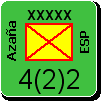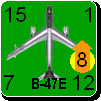Froonp
Posts: 7995
Joined: 10/21/2003
From: Marseilles, France
Status: offline

|
quote:
ORIGINAL: Extraneous
This is an attempt, for me, to get a clarification of the rules and not an attempt to bash them.
Lets say I’m wrong on Aligning Minor Powers and use the RAW.
I have stated you can only "align" the following:
Axis minor countries that can be aligned: Argentina, Bulgaria, Finland, Hungary, Rumania, Persia and Iraq, Siam, Spain, Sweden, Turkey, and Yugoslavia.
Allied minor countries that can be aligned: Brazil, Bulgaria, Central America, Mexico, Mongolia, and Yugoslavia.
quote:
ORIGINAL: WiFFE-RAW-7.o.pdf
In every other case, when one or more major powers declare war on a minor country, choose an active major power on the other side to align with it.
If there is more than one eligible major power, offer the minor to the major power whose capital city is closest to the minor’s capital (any home country in the case of the Commonwealth). If it declines, offer it to the next closest, and so on.
If every eligible major power declines, the minor (and all its controlled minors and territories) is immediately conquered by the attacking major power (see 13.7.1).
But…
quote:
ORIGINAL: WiFFE-RAW-7.o.pdf
If a neutral minor can align with your major power (see 19.6, 19.7 and 19.8), you can declare that it is aligning with you. You can only declare one minor aligned with your major power in each friendly impulse.
Your major power controls a minor that aligns with it exactly as if another major power had declared war on it.
When the U.S. and U.S.S.R are neutral major powers and the CW and France are the only active major powers.
This would mean that the CW could align one (1) minor power and France could align one (1) minor power.
Does this mean when Germany DOWs more than two (2) neutral minor powers.
Any DOWed minor power not aligned by the CW or France would be immediately compleatly conquered by Germany?
The limit of 1 alignement of minor country per impulse is for the align minor step only.
The D2.1 Declare war (RAW 9.) stage is composed multiple minor steps that are :
- DoW Major (RAW 9.2)
- DoW Minor (RAW 9.2)
- US Entry (RAW 9.4)
- Neutrality Pacts (RAW 9.5)
- Call out reserves (RAW 9.6)
- Setup attacked minor's unit (RAW 9.7)
- Align Minor (RAW 9.8)
This is this last step (RAW 9.8) that is concerned by the limitation to 1 alignement per major power per impulsen, as specified in (RAW 9.8). The only Minor Countries that can be aligned during this step are detailed in RAW 19.6, 19.7, 19.8 that you listed in your post.
There are no limits to the number of countries that can be declared war in the first 2 steps (DoW Major & DoW Minor described in RAW 9.2), and so no limits on the number of countries that can align to a major due to these DoWs. Except during the first 2 impulses of the game (see RAW 9.3).
If Germany declares war to Denmark, the Netherlands, Belgium in impulse 4 of the Global War scenarion, then the CW may align them all if they want. If they had the necessary conditions to align one of the RAW 19.6, 19.7, 19.8 minor countries, they could align 1 extra one during the last step of the DoW stage (RAW 9.8).
|
 Printable Version
Printable Version










 Thx.
Thx.






 New Messages
New Messages No New Messages
No New Messages Hot Topic w/ New Messages
Hot Topic w/ New Messages Hot Topic w/o New Messages
Hot Topic w/o New Messages Locked w/ New Messages
Locked w/ New Messages Locked w/o New Messages
Locked w/o New Messages Post New Thread
Post New Thread